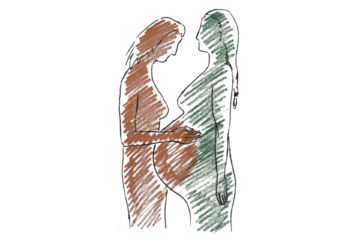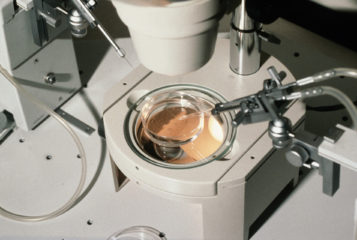When life takes an unexpected turn, people undergoing fertility treatment can be confronted with difficult decisions about the use and storage of gametes or embryos – sometimes decisions they made (or did not make) many years previously.
Introducing the Progress Educational Trust (PET)'s event, 'Till Death Do Us Part: Embryos and Gametes after Death Divorce or Separation', PET's director Sarah Norcross highlighted the uncomfortable (but thankfully rare) situations in which some people undergoing fertility treatment find themselves.
Recent research commissioned by PET and carried out by Ipsos showed public support for the posthumous use of sperm or eggs for conception, by a partner or family member of the deceased. But complex questions remain. What is the status of material in storage? Who gets to decide what is done with it? In what circumstances is posthumous use permitted? This debate explored the complex legal, medical, and practical considerations if people who have sperm, eggs or embryos in storage separate from their partner, or if they die.
First to speak was Robert Gilmour, a family lawyer at SKO Family Law Specialists in Edinburgh, who discussed the legal implications of relationship breakdown for couples undergoing fertility treatment before the point at which a pregnancy is established. When disputes arise relating to stored gametes or embryos, the law looks to the parties' consent, he explained, and relationship status is not relevant.
The Human Fertilisation and Embryology Act 1990 does not view the couple as a unit but rather as individuals, each of whom must give consent, and where each party is entitled to withdraw or vary that consent. Not only does this presents practical considerations for clinics (who must take consent from patients), it also leads to numerous variations in use of gametes or embryos for which specific consent is required.
In terms of Scottish divorce law, stored gametes and embryos are not viewed as property (see Holdich v Lothian Health Board) so the court cannot direct who should own them, although Gilmour pointed out that a court could require one party to pay storage fees. He finished by saying that this leaves a legal gap when a couple has embryos created from donor eggs and donor sperm, where neither can withdraw consent, but since the embryos are not viewed as property they cannot be legally divided or allocated in the event of separation.
Next to speak was Professor Abha Maheshwari, lead clinician at Fertility Scotland. Professor Maheshwari outlined the requirement for additional consents and screening for those who would like the option for their gametes or embryos to be used in surrogacy if they should die. She explained that if someone dies before any required screening is due, then the gametes cannot be used posthumously by anyone except their partner. In cases where the surviving partner is male or cannot otherwise carry the pregnancy, that means the gametes cannot, in practice, be used.
Those undergoing treatment must therefore plan carefully in advance. However, screening incurs significant additional costs, which healthy couples may not wish to commit to given the remote possibility of premature death.
The next speaker, James Lawford Davies, partner in Hill Dickinson's health team, discussed a range of important legal decisions from the Diane Blood case (see BioNews 924) to the recent Jennings v Human Fertilisation and Embryology Authority decision (see BioNews 1146). All these cases turned on the issue of consent, where the courts have had to consider whether the posthumous use of gametes or embryos could be permitted in circumstances where formal consent requirements may not have been met.
In some cases, in the absence of the correct forms being filled in, parties were unable to persuade the court of their intention to use reproductive material in the requested manner. In other cases, there was sufficient evidence to permit the court to infer consent to give effect to the wishes of the deceased. These decisions demonstrate that in the absence of consent, a decision can only be made on a case-by-case basis by the court. As Lawford Davies illustrated, there may be circumstances in which the court can give effect to the wishes of the deceased, but in the absence of a court order,the position remains that there must be consent in place.
A busy question-and-answer session followed the presentations. Asked whether recent additions to consent forms are 'overkill' in relation to something that is not likely to happen, Professor Maheshwari explained that while consent forms could be made more explicit, they operate in the interests of transparency and give patients choice. It is better to be honest and transparent with information given to the patient, she said. Similarly, Lawford Davies took the view that the emphasis should be on communication between the clinic and patients about the forms, rather than the forms themselves. The new forms might be an improvement in some respects, but there always remains the potential for patients to not read them properly, he said.
The speakers were also asked if they would recommend a cooling off period, or arbitration, or conflict resolution when couples who have created embryos together split up. Lawford Davies said clinics should encourage the couple to resolve their issues, rather than getting involved in their client's personal dispute. He said that some clinics have found that couples have reconciled during a cooling-off period. Gilmour was also supportive of a cooling-off period, if couples cannot agree on what should happen to embryos before making irrevocable decisions.
Finally, the speakers were asked whether the use of stored gametes or embryos by the deceased's parents is ever appropriate. For Lawford Davies, the answer is fact and case-specific and shouldn't detract from the relevance of the wishes of the parties. Similarly, Professor Maheshwari said all possibilities should be looked at, while Gilmour said there can be circumstances where it is appropriate, but those circumstances would need to be looked at very carefully.
This discussion illustrated how the application of bright-line rules around consent is extremely fact-sensitive and varied. Achieving the right balance and just results involves not only encouraging those undertaking fertility treatment to plan for such eventualities, but also requires clinics to ensure that patients are fully informed about all aspects of treatment, including life's unexpected eventualities.
Practical and legal considerations aside, Lawford Davies highlighted that all cases discussed involved brave, strong people faced with tragedy and unexpected suffering and who wanted to fulfil the wishes of a loved one who had died. Amid the bureaucracy of consent, it is worth remembering this.
PET is grateful to the Scottish Government for supporting this event.
The next online event from PET, taking place next week (on Wednesday 7 December 2022), will be the PET Annual Conference 'Making Fertility Treatment Fair: Equality in Access, Equality in Outcome?'.
Find out more and register here.






Leave a Reply
You must be logged in to post a comment.